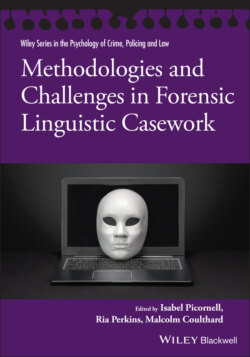Читать книгу Methodologies and Challenges in Forensic Linguistic Casework - Группа авторов - Страница 7
ОглавлениеSeries Preface
The Wiley Series in the Psychology of Crime, Policing, and the Law publishes both single and multi-authored monographs and edited reviews of emerging areas of contemporary research. The purpose of this series is not merely to present research findings in a clear and readable form, but also to bring out their implications for both practice and policy. Books in this series are designed not only for psychologists, but also for all those involved in crime detection and prevention, child protection, policing, and judicial processes.
As the editors of Methodologies and Challenges in Forensic Linguistic Casework remind us, issues around the authorship and identity of written and spoken words reach back to Biblical times — the origins of the term ‘shibboleth’— through the true author(s) of Shakespeare’s plays and more recently, the musings of Sherlock Holmes and other fictional detectives. In our current century, these matters have assumed a new significance, where the validity and identity of electronic messaging and voice mail is, for many of us a daily challenge, while academics and students routinely employ the ‘Turnitin’ program to detect and prevent plagiarism.
An earlier volume in the Wiley Series had included some significant contributions on these themes (Oxburgh, Myklebust, Grant, & Milne, 2016), but this is the first book to be devoted entirely to forensic linguistics: an emerging science which combines the insights of psychology and linguistics in new and creative ways. Throughout its development, it has sought to combine theory with application and as the new book illustrates, its progenitors have found themselves caught up in major investigations both in the civil and criminal matters. One early high-profile case concerned the hunt for the serial killer known as the ‘Yorkshire Ripper’. In 1979, the police received a taped message, purportedly from the perpetrator, ridiculing their faltering investigations to date. The tape was passed to linguists at Leeds University who were asked to comment on the accent of the speaker. Their analysis of the cadences led them to conclude that he probably came from the village of Castletown, a suburb of Sunderland. This location fell well outside the suspect search area and was thoroughly investigated before being eventually discounted by the investigators. When the real murderer, Peter Sutcliff, was arrested, it was evident that the tape had been a hoax. The perpetrator, John Humble, who was subsequently arrested and convicted in 2006, had spent most of his life in and around Castletown, so the linguists had been correct in their judgement (Bilton, 2012).
As this case illustrates, forensic linguistics covers a wide and developing field and the editors have sought to impose some organizational structure to encompass the diverse contributions that are celebrated in its pages. One theme which unites all the contributions is the search for objective measures and replicable procedures: in other words, new investigators, faced with the same corpus of material, should independently be able to reach the same conclusions. Section 1 deals with anonymous or disputed authorship: in the opening contribution, Tim Grant and Jack Grieve demonstrate how meticulous regard for objective methods can avoid confirmation bias—the tendency of experts of all shades to report what is expected or invited, a feature of forensic investigation mercilessly exposed through the research of Itiel Dror (Dror, 2018). Section 2 is given over to issues around the meaning and interpretation of spoken and written communications. A forensic linguistic analysis of the police transcripts in California v. Ceja by Gerald McMenamin demonstrates how a Spanish-American defendant failed to understand the intent of the ‘Miranda’ warning, read to all suspects prior to US police interviews, and so lost access to her constitutional rights to be legally represented and avoid self-incrimination. Not for the first, and certainly not the last, time, the Court of Appeal rejected this submission based on the new science. How long, I wonder, before a case occurs in England where a migrant refugee claims not to have understood the implications of the standard Police Caution? They will be fortunate if they have the support of an expert like McMenamin.
The Editors of this new text, Isabel Picornell, Malcom Coulthard and Ria Perkins are all experienced forensic linguists currently or previously associated with the Centre for Forensic Linguistics at Aston University, which Emeritus Professor Coulthard, a true pioneer of this field, was a founder. In 2019, recognising the growing importance of the discipline, support from Research England enabled the Centre to become the Aston Institute for Forensic Linguistics with greatly expanded staff and facilities, now under the leadership of Professor Grant.
Methodologies and Challenges in Forensic Linguistic Casework deserves to be widely read by professionals and students of psychology and linguistics and indeed, all those interested in the application of forensic science to language and the new ways in which, text, messages and the spoken word can be analysed to reveal new information about the nature and identity of the authors.
Graham M. Davies
University of Leicester
REFERENCES
1 Bilton, M. (2012). Wicked beyond belief: The hunt for the Yorkshire Ripper. London: Harper-Collins.
2 Dror, I. E. (2018). Biases in forensic experts. Science, 360( 6386), 243.
3 Oxburgh, G., Myklebust, T., Grant, T., & Milne, R. (2016). Communication in investigative and legal contexts. Chichester, UK: Wiley-Blackwell.
